|
|
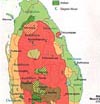 |
==Tamil
in Sri Lanka (c.1300): "A Tamil-speaking kingdom is
established
on the Jaffna Peninsula of Sri Lanka. This marks the beginning of a
gradual
linguistic division of the island between Tamil in the north and east
and
Sinhalese to the south and west" (--Met). |
 |
==More
trouble from the Mongols-- In 1303 the Mongols actually
besiege
Delhi, and the sultan, 'Ala ud-Din Khilji, is forced to leave the city;
but after two months the Mongols retire (because of the prayers of
Hazrat
Nizamuddin, some say). The sultan now takes energetic military
measures.
The Mongols invade in 1305 and again in 1306, but 'Ala- ud-Din's
officers
have such military success that they even take the offensive; after
this
there is a long respite from Mongol attacks. |
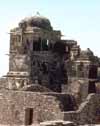 |
=='Ala
ud-Din Khilji (r.1296-1316): This energetic ruler
invades
Devagiri in the Deccan, conquers Gujarat, captures the important fort
of
Chitor, makes major incursions into the south (with some help from
southern
allies); considers establishing a new religion or conquering the world,
but is dissuaded; takes many authoritarian measures; experiments with
price
controls; presides over a brilliant cultural flowering. Discussion: *Ikram
Ch. 5*; *India
Nest*. (*Routes*) |
 |
==More
cities of Delhi: 'Ala ud-Din Khilji creates a layer of
Delhi
called "Siri" (*delhi
gov*); then Ghiyasuddin Tughluq (r.1320-25) constructs
"Tughluqabad"
(*ANU*;
*Berger*).
After that comes the "Firozabad" (or Firoz Shah ka Kotlah) of Firoz
Shah
Tughluq (r.1351-88) (*archnet*).
Discussion: *India
Nest*. (*Routes*) |
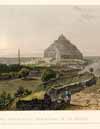 |
==Daulatabad:
Delhi in the Deccan? In 1327, Muhammad Shah Tughluq
(r.1325-51)
decides that since his kingdom now includes (nominally) most of India,
he should govern from a more central location. So he orders the whole
population
of Delhi to trek down to Devagiri (which he renames Daulatabad) in the
Deccan. Many poor people die on the way, but the cultural ferment
produced
in the new capital of Daulatabad plays a large role in the growth of
what
will later become Urdu. The project never quite works, though, and by
1335
he's obliged to give it up. Discussion: *Ikram
Ch. 5*. Images: *Tokyo
Univ.*; *Berger*
(early among the "Ellora" ones). (*Routes*) |
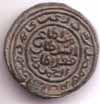 |
==Muhammad
Shah's bronze coin experiment (c.1330-32): Muhammad Shah
Tughluq issues coins made not of silver or gold, but of bronze, and
tries
in vain to get them accepted in the marketplace. The resulting turmoil
(and counterfeiting) almost wrecks the economy, and he has to abandon
the
attempt. He was too far ahead of his time. |
 |
==Ibn
Battuta visits (c.1333–47): Ibn Battuta (1304–78),
the famous traveler, adventurer, and chronicler from Tangier, spends
time
in India, serves as a qazi in Delhi--and even travels to China as an
ambassador
for Muhammad Shah Tughluq. Excerpts from his account of his Indian
visit:
*MSSU*. |
 |
==The
Bahmanids form a new kingdom in the Deccan
(c.1345-1528):
Muhammad Shah Tughluq loses the southern parts of his never-very-secure
realm. In the Deccan, one of his generals rebels, gives himself a fancy
Persian name, and founds the Bahmanid kingdom (*wiki*),
with its capital at Gulbarga (*U.
Tokyo*). (In the early 1500's, this kingdom fragments into several
smaller successors.) More background on the Bahmanids: *cloud
band*. (*Routes*) |
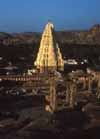 |
==Vijayanagar
dazzles visitors (c.1343-1565): In South India,
Vijayanagar,
another new state, also takes shape as the tide of the Delhi Sultanate
recedes. Its capital is one of the richest cities in the world, with
impressive
palaces and enormous gateways. Both architecturally and culturally,
Vijayanagar
is built of a mixture of indigenous elements and Islamic influences.
Its
Hindu rulers refer to themselves as "sultans among kings," wear
variations
of Muslim court dress, and freely make (and break) military alliances
with
neighboring states on political, not religious, grounds. William
Dalrymple
(*Outlook*
or *CU*)
shows how radically V. S. Naipaul and others have misrepresented its
history.
Further discussion: Sanjay Subramanyam (*Outlook*
or *CU*).
More on its architecture: *art
and archaeology*; *cloud
band*. (*Routes*) |
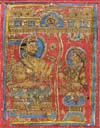 |
==Jain
painting reaches a high point (c.1350): "Jain painting
reaches
its greatest refinements in Gujarat and Rajasthan. Paintings typically
illustrate sacred texts such as the Kalpasutras, and are characterized
by their angular figures with protruding eyes" (--Met).
Along with paintings, Jain bhandars, or manuscript storehouses, are
invaluable
refuges for many medieval texts that would otherwise have been lost.
More
paintings: *Schoyen*;
*Met*.
(*Routes*) |
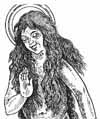 |
==Lal
Ded (c.1355?- ?): A Kashmiri poet-saint of the bhakti
tradition,
Lal Ded is traditionally placed in this century. She is said to
renounce
her marriage and family, and take as her husband the god Shiva alone.
From
then on she wanders naked on the roads like a madwoman, singing her
songs
of love and mystical devotion. Discussion: *kashmir
herald*; *Jaishree
Odin, Manushi 138*. |
 |
==Sir
John Mandeville (c.1366), in his fanciful but extremely
popular
"Travels," has a great deal to say about India and the vicinity,
including
"wherefore the emperor of Ind is clept (called) Prester John" (Chapter
32), and the story of the gold-digging ants (Chapter 33), and about the
headless people and other Herodotus-like wonders (Chapter 22): *romanization*. |
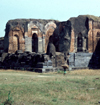 |
==Muslims
in Bengal: The Adina Mosque (1375) was a sign of cultural
and political change coming to Bengal too, as Muslims began to arrive
and
settle there. See Chapter Three in Richard M. Eaton's *The
Rise of Islam and the Bengal Frontier*. |
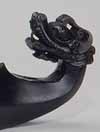 |
==Timur
sacks Delhi, 1398: The Mongol ruler Timur, known as
Tamerlane
(for "Timur-i lang," Timur the Lame) (1336–1405), takes advantage of
the
fragmenting of the Delhi Sultanate to invade Delhi itself and sack the
city, slaughtering much of the population. This terrible defeat
basically
finishes off the Delhi Sultanate, though weak rulers linger for some
time,
and then the Lodhis try to rebuild. More on Timur: *silk
road* and the *Tarikh-i-Rashidi*.
For the artistic side of Timur: *Met* |
|
|















